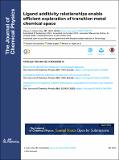Ligand additivity relationships enable efficient exploration of transition metal chemical space
Author(s)
Arunachalam, Naveen; Gugler, Stefan; Taylor, Michael G; Duan, Chenru; Nandy, Aditya; Janet, Jon Paul; Meyer, Ralf; Oldenstaedt, Jonas; Chu, Daniel BK; Kulik, Heather J; ... Show more Show less
DownloadPublished version (5.874Mb)
Publisher with Creative Commons License
Publisher with Creative Commons License
Creative Commons Attribution
Terms of use
Metadata
Show full item recordAbstract
<jats:p> To accelerate the exploration of chemical space, it is necessary to identify the compounds that will provide the most additional information or value. A large-scale analysis of mononuclear octahedral transition metal complexes deposited in an experimental database confirms an under-representation of lower-symmetry complexes. From a set of around 1000 previously studied Fe(II) complexes, we show that the theoretical space of synthetically accessible complexes formed from the relatively small number of unique ligands is significantly (∼816k) larger. For the properties of these complexes, we validate the concept of ligand additivity by inferring heteroleptic properties from a stoichiometric combination of homoleptic complexes. An improved interpolation scheme that incorporates information about cis and trans isomer effects predicts the adiabatic spin-splitting energy to around 2 kcal/mol and the HOMO level to less than 0.2 eV. We demonstrate a multi-stage strategy to discover leads from the 816k Fe(II) complexes within a targeted property region. We carry out a coarse interpolation from homoleptic complexes that we refine over a subspace of ligands based on the likelihood of generating complexes with targeted properties. We validate our approach on nine new binary and ternary complexes predicted to be in a targeted zone of discovery, suggesting opportunities for efficient transition metal complex discovery. </jats:p>
Date issued
2022-11-14Department
Massachusetts Institute of Technology. Department of Chemical Engineering; Massachusetts Institute of Technology. Department of ChemistryJournal
The Journal of Chemical Physics
Publisher
AIP Publishing
Citation
Arunachalam, Naveen, Gugler, Stefan, Taylor, Michael G, Duan, Chenru, Nandy, Aditya et al. 2022. "Ligand additivity relationships enable efficient exploration of transition metal chemical space." The Journal of Chemical Physics, 157 (18).
Version: Final published version